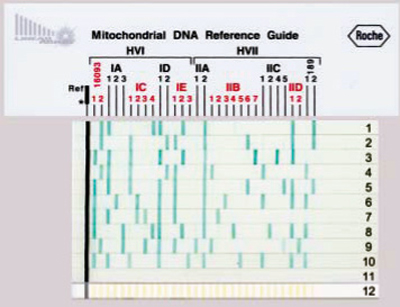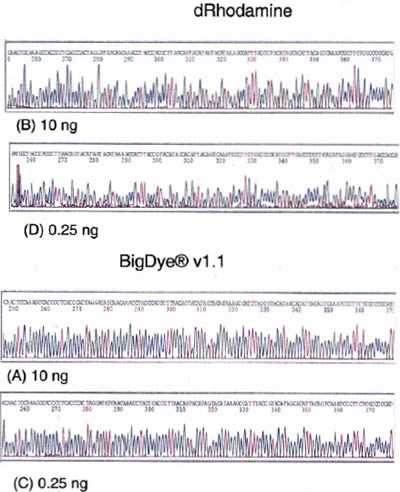Archival Notice
This is an archive page that is no longer being updated. It may contain outdated information and links may no longer function as originally intended.
Home | Glossary | Resources | Help | Contact Us | Course Map
The Linear Array mtDNA HVI/HVII Region-Specific Typing Kit (Roche Applied Science) is a sequence-specific oligonucleotide hybridization technique.28 This technique is used as a screening assay and eliminates the need to perform more costly direct sequencing of all samples.
Example |
|---|
| A detective submits a single pubic hair for mtDNA analysis, the victim reference standard, and standards for ten suspects. With the linear array assay, the analyst may be able to exclude the victim and eight suspects as the donor of the pubic hair. This would leave three samples needing direct sequencing: the pubic hair sample and the samples from the two suspects not excluded. |
The linear array assay has sequence-specific oligonucleotide (SSO) probes immobilized on a membrane very similar in design to the AmpliType PM + DQA1 Typing Kit.29 Biotinylated PCR (Polymerase Chain Reaction) products hybridize to the SSO probes with the exact sequence complement. Common polymorphic sites are interrogated.28 All biotinylated PCR products hybridized to the SSO probes are detected with streptavidine-horseradish peroxidase conjugate. A chromogenic substrate produces a blue precipitate on the membrane. It is this pattern of "thin blue lines" that detects sequence variants to the rCRS. All samples not excluded with this typing kit can be analyzed with direct sequencing methods to evaluate the full hypervariable regions, using the original amplicons. Data is reviewed to obtain additional sequence information to confirm the original match or determine it to be a non-match.
Additional Online Courses
- What Every First Responding Officer Should Know About DNA Evidence
- Collecting DNA Evidence at Property Crime Scenes
- DNA – A Prosecutor’s Practice Notebook
- Crime Scene and DNA Basics
- Laboratory Safety Programs
- DNA Amplification
- Population Genetics and Statistics
- Non-STR DNA Markers: SNPs, Y-STRs, LCN and mtDNA
- Firearms Examiner Training
- Forensic DNA Education for Law Enforcement Decisionmakers
- What Every Investigator and Evidence Technician Should Know About DNA Evidence
- Principles of Forensic DNA for Officers of the Court
- Law 101: Legal Guide for the Forensic Expert
- Laboratory Orientation and Testing of Body Fluids and Tissues
- DNA Extraction and Quantitation
- STR Data Analysis and Interpretation
- Communication Skills, Report Writing, and Courtroom Testimony
- Español for Law Enforcement
- Amplified DNA Product Separation for Forensic Analysts



